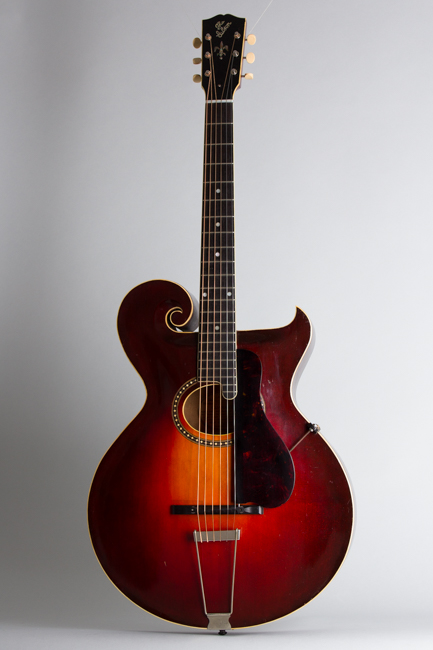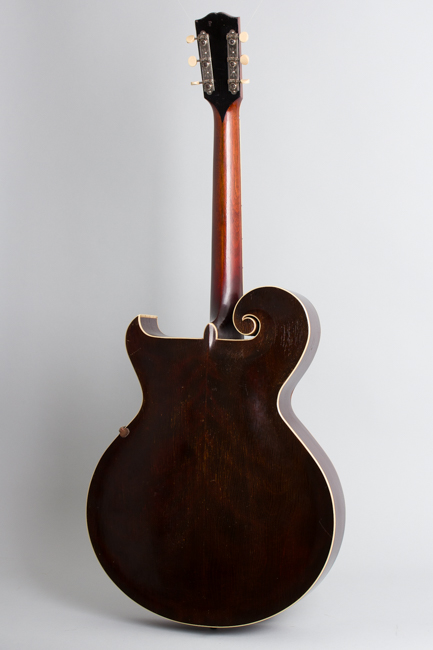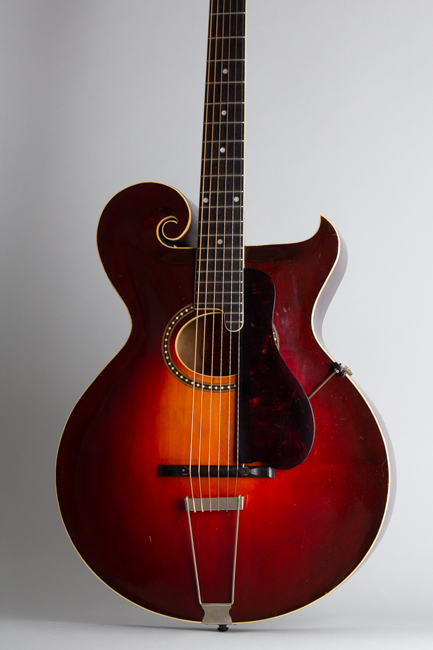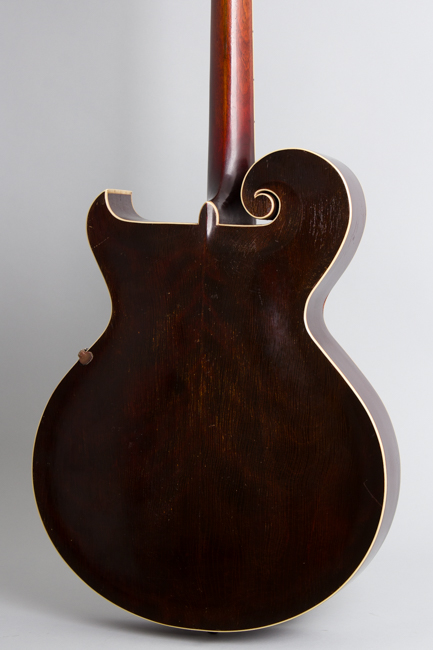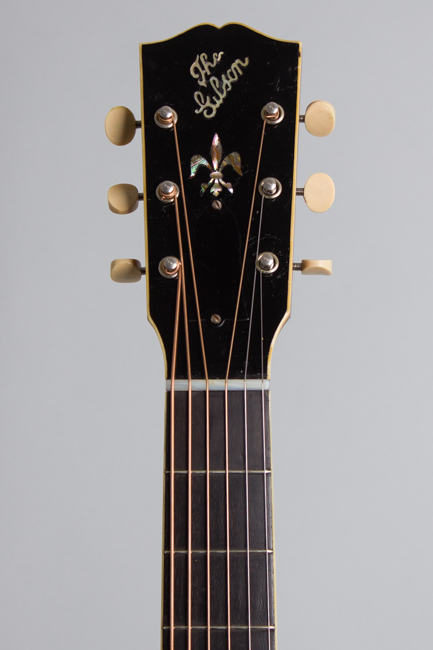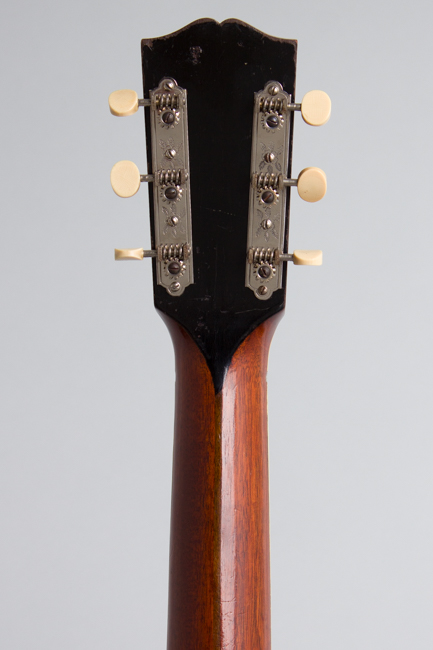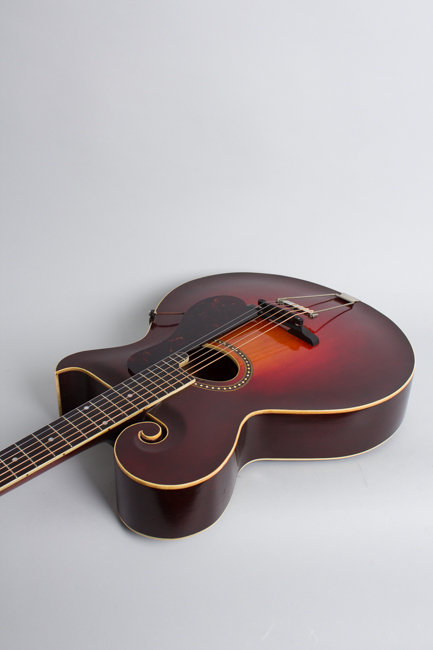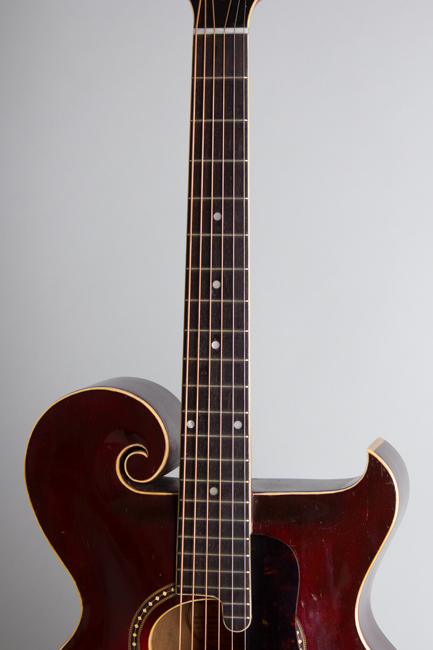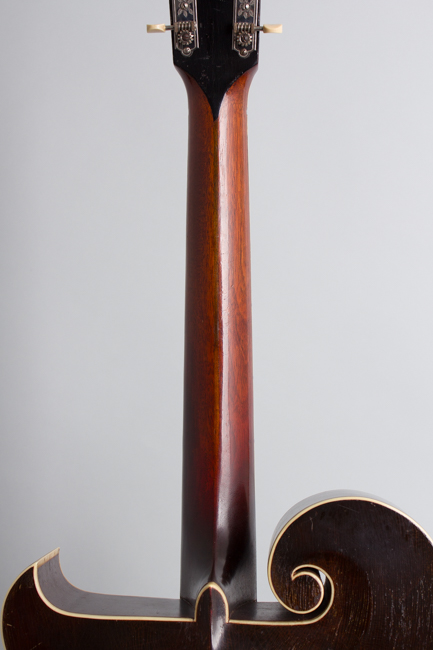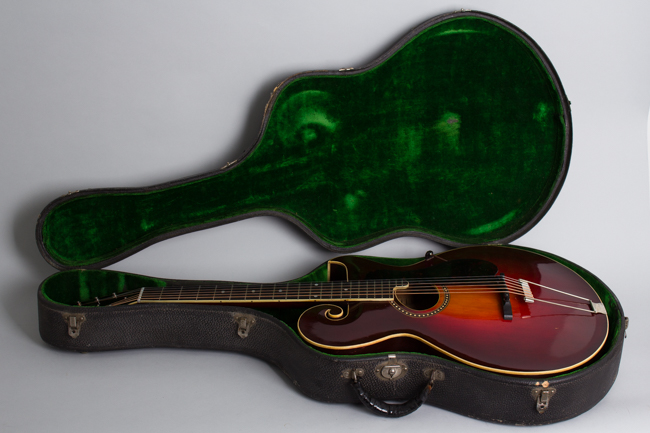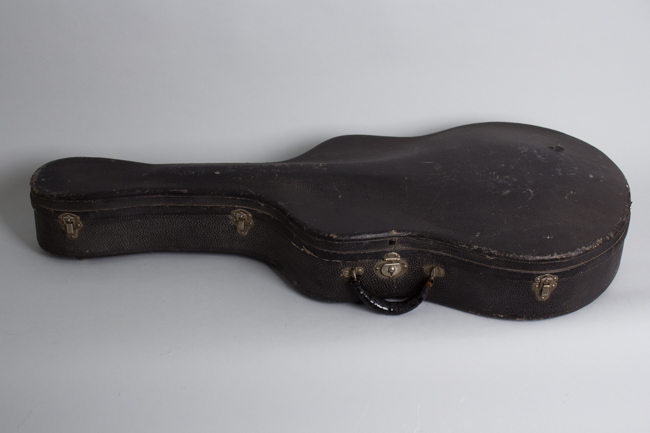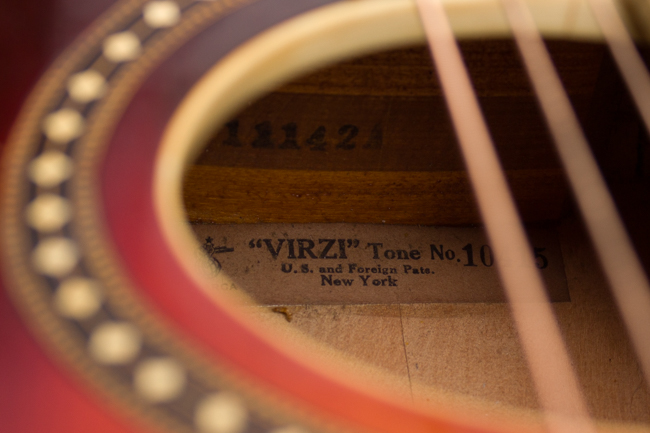Gibson Style O Artist with Virzi Arch Top Acoustic Guitar (1924)
Gibson Style O Artist with Virzi Model Arch Top Acoustic Guitar (1924), made in Kalamazoo, Michigan, serial # 79408, red sunburst varnish finish, birch back and sides, spruce top; mahogany neck with ebony fingerboard, original black hard shell case.
This lovely guitar represents the final gasp of a signature Gibson tradition as it appears to be one of THE last batch of Style O Artist Model guitars ever made, at least according to the information currently available. These were one of the company's most visually arresting creations, unmistakable even from 100 yards away. This Style O is also fitted with one of Lloyd Loar's obsessions, a "Virzi Tone Producer" marketed by Virzi Bros. violin company in New York. This consists of a thin flat spruce disc mounted under the top just behind the soundhole. It was claimed to boost vibrations in the sound chamber, supposedly enhancing harmonic partials. Championed by Loar, it was offered by Gibson as an optional extra cost feature at the time but was mostly seen in the expensive Gibson Master Model mandolins. It is very uncommon to find one in any guitar, let alone a Style O.
The Style O "Special Grand Concert Artist Model" was introduced in 1908 as Gibson's new version of their top of the line 6-string guitar. Originally designed to harmonize with the company's mandolin orchestra instruments, the Style O Artist has an elegantly scrolled upper bout and a dramatic swooping cutaway on the treble side. This feature allows more access to the fingerboard than any guitar of the period, and indeed the 15th fret neck joint was a revolutionary if under-appreciated idea at the time.
The Style O was one of Gibson art Nouveau masterpieces, but by the "Loar era" had reached the end of its run. It was last cataloged in 1922, two years before this one was made; this guitar's FON and serial number indicate a mid-1924 time frame for its build. Probably the influence of Lloyd Loar (who helped design its replacement as Gibson's top-line 6 string, the L-5) the Style O was dropped from Gibson's catalog. 1923-4 was a time of major changes at Gibson, with Loar's Style 5 Master Models now coming off the line. Still apparently the company continued to fill the occasional order for the Style O even though it looked like a relic of earlier times; there must have been some demand from Gibson's dealers, or just parts left in stock!
These last examples received many of the latest Gibson features for 1923-4 that would characterize the L-5. The adjustable ebony bridge, all-metal "string over tailpiece" and most important the then-new adjustable truss rod are all present. Only the very last Style Os are so equipped. Classic appointments of the model include (of course) the elegantly scrolled cutaway body, single bound in heavy ivoroid top and back, chunky V-profile neck and bound headstock with a pearl Fleur-De-Lys and "The Gibson" script inlay. The oval soundhole has an elaborate multi-part rosette, partially covered by the elevated pickguard. The ebony fingerboard is bound with pearl dot inlay, with a small 2-fret extension on the treble end and a genuine pearl nut.
This Style O is a older feeling design but one of the best-sounding of these we have had, with a thinner carved top imparting a rounder tone and more responsive feel than earlier examples. It is hard to tell if the Virzi has any actual effect on the tone, but Loar would have claimed it did! The neck is quite large but still manageable, this is a genuinely playable and better-sounding instrument than many would expect.
Atlanta orchestra guitarist/banjoist Perry Bechtel played a similar late-model Style O before the Martin OM was designed for him; he is pictured in later 1920s Gibson catalogs with it. This Loar-era, Virzi equipped example is not only a cool piece of Gibson history but as good an instrument as these get, more of a player than most and a very rare piece still housed in its original shaped HHSC.
Overall length is 38 1/2 in. (97.8 cm.), 16 in. (40.6 cm.) wide at lower bout, and 3 1/4 in. (8.3 cm.) in depth, measured at side of rim. Scale length is 24 3/4 in. (629 mm.). Width of nut is 1 3/4 in. (44 mm.).
This guitar has some fairly minor wear overall, but is very well preserved considering it is just coming up on its 100th birthday! There is fairly minor finish checking and small dings overall, with one noticeable case lid ding on the top above the tailpiece.
The back has heavier checking with some minor flaking and a few deeper scratches. The lacquer on the back of the neck is worn a bit in the lower positions with small dinks. Really though the finish overall is very fine for a Gibson of this period, the top shining like it did when "Silent Cal" Coolidge was in the white house.
There are no heel cracks (common on this model) or indeed any other crack repairs visible, and none of the often seen overspray or added finish. The hardware is original except for a very nicely done repro pickguard with the original bracket, and a perfectly crafted lower-profile repro saddle on the original ebony bridge base. The original ebony bridge with the turn-over Hawaiian saddle is still in the case pocket. The tuners, tailpiece and pearl nut remain original.
The frets are original and have been crowned down a bit, but really this guitar simply does not appear played that much since 1924. 100 years on this relic of the transition between the "old" and "new" Gibsons under the direction of Master Loar (including his beloved Virzi) is just about as nice as it could be, better playing and sounding than most residing in a well-preserved original shaped Gibson hard case. Overall Excellent - Condition.
This lovely guitar represents the final gasp of a signature Gibson tradition as it appears to be one of THE last batch of Style O Artist Model guitars ever made, at least according to the information currently available. These were one of the company's most visually arresting creations, unmistakable even from 100 yards away. This Style O is also fitted with one of Lloyd Loar's obsessions, a "Virzi Tone Producer" marketed by Virzi Bros. violin company in New York. This consists of a thin flat spruce disc mounted under the top just behind the soundhole. It was claimed to boost vibrations in the sound chamber, supposedly enhancing harmonic partials. Championed by Loar, it was offered by Gibson as an optional extra cost feature at the time but was mostly seen in the expensive Gibson Master Model mandolins. It is very uncommon to find one in any guitar, let alone a Style O.
The Style O "Special Grand Concert Artist Model" was introduced in 1908 as Gibson's new version of their top of the line 6-string guitar. Originally designed to harmonize with the company's mandolin orchestra instruments, the Style O Artist has an elegantly scrolled upper bout and a dramatic swooping cutaway on the treble side. This feature allows more access to the fingerboard than any guitar of the period, and indeed the 15th fret neck joint was a revolutionary if under-appreciated idea at the time.
The Style O was one of Gibson art Nouveau masterpieces, but by the "Loar era" had reached the end of its run. It was last cataloged in 1922, two years before this one was made; this guitar's FON and serial number indicate a mid-1924 time frame for its build. Probably the influence of Lloyd Loar (who helped design its replacement as Gibson's top-line 6 string, the L-5) the Style O was dropped from Gibson's catalog. 1923-4 was a time of major changes at Gibson, with Loar's Style 5 Master Models now coming off the line. Still apparently the company continued to fill the occasional order for the Style O even though it looked like a relic of earlier times; there must have been some demand from Gibson's dealers, or just parts left in stock!
These last examples received many of the latest Gibson features for 1923-4 that would characterize the L-5. The adjustable ebony bridge, all-metal "string over tailpiece" and most important the then-new adjustable truss rod are all present. Only the very last Style Os are so equipped. Classic appointments of the model include (of course) the elegantly scrolled cutaway body, single bound in heavy ivoroid top and back, chunky V-profile neck and bound headstock with a pearl Fleur-De-Lys and "The Gibson" script inlay. The oval soundhole has an elaborate multi-part rosette, partially covered by the elevated pickguard. The ebony fingerboard is bound with pearl dot inlay, with a small 2-fret extension on the treble end and a genuine pearl nut.
This Style O is a older feeling design but one of the best-sounding of these we have had, with a thinner carved top imparting a rounder tone and more responsive feel than earlier examples. It is hard to tell if the Virzi has any actual effect on the tone, but Loar would have claimed it did! The neck is quite large but still manageable, this is a genuinely playable and better-sounding instrument than many would expect.
Atlanta orchestra guitarist/banjoist Perry Bechtel played a similar late-model Style O before the Martin OM was designed for him; he is pictured in later 1920s Gibson catalogs with it. This Loar-era, Virzi equipped example is not only a cool piece of Gibson history but as good an instrument as these get, more of a player than most and a very rare piece still housed in its original shaped HHSC.
Overall length is 38 1/2 in. (97.8 cm.), 16 in. (40.6 cm.) wide at lower bout, and 3 1/4 in. (8.3 cm.) in depth, measured at side of rim. Scale length is 24 3/4 in. (629 mm.). Width of nut is 1 3/4 in. (44 mm.).
This guitar has some fairly minor wear overall, but is very well preserved considering it is just coming up on its 100th birthday! There is fairly minor finish checking and small dings overall, with one noticeable case lid ding on the top above the tailpiece.
The back has heavier checking with some minor flaking and a few deeper scratches. The lacquer on the back of the neck is worn a bit in the lower positions with small dinks. Really though the finish overall is very fine for a Gibson of this period, the top shining like it did when "Silent Cal" Coolidge was in the white house.
There are no heel cracks (common on this model) or indeed any other crack repairs visible, and none of the often seen overspray or added finish. The hardware is original except for a very nicely done repro pickguard with the original bracket, and a perfectly crafted lower-profile repro saddle on the original ebony bridge base. The original ebony bridge with the turn-over Hawaiian saddle is still in the case pocket. The tuners, tailpiece and pearl nut remain original.
The frets are original and have been crowned down a bit, but really this guitar simply does not appear played that much since 1924. 100 years on this relic of the transition between the "old" and "new" Gibsons under the direction of Master Loar (including his beloved Virzi) is just about as nice as it could be, better playing and sounding than most residing in a well-preserved original shaped Gibson hard case. Overall Excellent - Condition.
